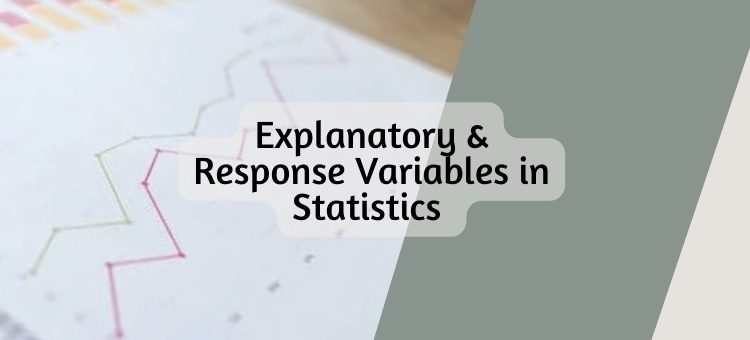Explanatory & Response Variable in Statistics — A quick guide for early career researchers!

Often researchers have a difficult time choosing the parameters and variables (like explanatory and response variables) that answer their aims and objectives in research study. The primary objective of any study is to determine whether there is a cause-and-effect relationship between variables.
Therefore, in experimental research, a variable is a factor that is not constant. An investigator can modify variables and control variables to determine if one variable has an effect on another variable in an experiment. However, researchers find it difficult to choose factors and parameters for their statistical study due to their lack of understanding of statistical variables.
There are several types of variables, but we will discuss two of the most commonly important variables — explanatory and response. This article will address their distinct attributes and their effects on research.
What Are Variables?
In statistics, a variable is defined as an attribute of an object of study. It is a characteristic that can assume different values. Furthermore, height, age, income, grades obtained at school and type of housing are all examples of variables. However, in statistical studies there are many types of variables and some variables are used more often than others. For example, continuous variables are used more frequently than dummy variables.
Types of Variables
Variables are majorly categorized into two main categories mentioned below. Furthermore, each category is further classified into subcategories.
Categorical Variable
The categorical variable has limited number of values. Furthermore, this variable is a collection of information divided into groups and gives categorical data.
Categorical variables are of three types: Binary, nominal, and ordinal variables.
| Type | What the Data Represents | Categorical Variable Examples |
| Binary | Yes or no outcomes | Heads or tails in a flip coin Win or lose in a debate |
| Nominal | Groups with no rank or order between them | Species names Brands |
| Ordinal | Groups that are in a specific rank or order | Classification of species
Rating scale responses in a survey. |
Numeric Variable
The numeric variable is a quantifiable characteristic whose values are numbers (except for numbers which are codes for other categories). Moreover, numeric variables are either continuous or discrete.
| Type | What the Data Represents | Numeric Variable Examples |
| Discrete | Counts individual items or values | Number of students in a class
Number of trees in a particular forest |
| Continuous | Measurement of continuous or non-finite values | Distance Volume |
Most Common Types of Variables
Apart from the above mentioned types, variables are classified into many common and less common types. Here, we will discuss two of the most important variables that help investigate causal relationship between variables using experiments or observations in a research.
What is Explanatory Variable?
An explanatory variable is a type of independent variable. It is what a researcher manipulates or observes changes in. In other words, an explanatory variable is the expected cause, and it explains the results.
What is Response Variable?
A response variable is a type of dependent variable. It is the one that changes the results. Furthermore, a response variable is the expected effect, and it responds to explanatory variables.
Explanatory Vs. Response Variables
These two variables are related, wherein the change in the response variable happens only after changes in an explanatory variable.
There is a causal relationship between these variables either directly or indirectly. Furthermore, in an indirect relationship, an explanatory variable may act on a response variable through a mediator.
However, if a researcher is dealing with a correlational relationship, there will be no explanatory and response variables. The changes in one variable brings changes in another. This type of variable is confounding variable, another common type of variable.
Difference between Explanatory and Response Variables
- Explanatory variables are the variables that can be altered or manipulated in research (for example, a change in dosage) while response variable is the result of manipulation done to the variables (the time it took for the reaction to occur).
- An explanatory variable represents the expected cause that can explain the outcome of the research while response variables represent the effect that is expected as a response to the explanatory variable.
- Changes are visible in response variables only if changes occur in explanatory variables unlike explanatory variables that can change at any point in the test or research.
- Explanatory variables are the independent variables in a research. Meanwhile, response variables are the dependent variables.
Examples of Explanatory and Response Variables
Example 1: Cancer Treatment
In a research study, where you are trying to figure out if chemo or anti-estrogen treatment is a better procedure for breast cancer patients, the question to be addressed is — which procedure prolongs life more? And thus, survival time is the response variable. Meanwhile, the type of therapy given is the explanatory variable, which may or may not affect the response variable.
In this example, explanatory variable is type of treatment. However, in real life there could be several more explanatory variables, including: age, health, weight, and other lifestyle factors.
Example 2: Height & Age
A group of middle school students want to know if they can use height to predict age. They take a random sample of 50 people at their school, both students and teachers, and record each individual’s height and age. This is an observational study. Additionally, the students want to use height to predict age.
In this example, explanatory variable is height and response variable is age.
Example 3: Panda Fertility Treatments
A team of veterinarians want to compare the effectiveness of two fertility treatments for pandas in captivity. The two treatments are in-vitro fertilization and male fertility medications.
This experiment has one explanatory variable: type of fertility treatment. Meanwhile, the response variable is a measure of fertility rate.
Example 4: Public Speaking Approaches
A public speaking teacher developed a new lesson that she believes decreases student anxiety in public speaking situations more than the old lesson. Furthermore, she designed an experiment to test if her new lesson works better than the old lesson. Public speaking students are randomly assigned to receive either the new or old lesson; their anxiety levels during a variety of public speaking experiences are measured.
In this experiment, explanatory variable is the lesson received. While the response variable is the anxiety level.
Visualization of Explanatory and Response Variables
The easiest way to visualize explanatory and response variables is from a graphical representation. Moreover on a graph, the explanatory variable is conventionally placed on the x-axis, meanwhile the response variable is placed on the y-axis.
For quantitative variables, use a scatterplot or a line graph.
If the response variable is categorical, use scatterplot or a line graph.
If the explanatory variable is categorical, use a bar graph.
However, when you have only one explanatory and one response variable, you will acquire paired data. Furthermore, this means every response variable measurement is linked to an explanatory variable value for each participating unit.
Have you used these variables in research? Tell us or write to us if you have used explanatory or response variables in your research study.










Great
Useful